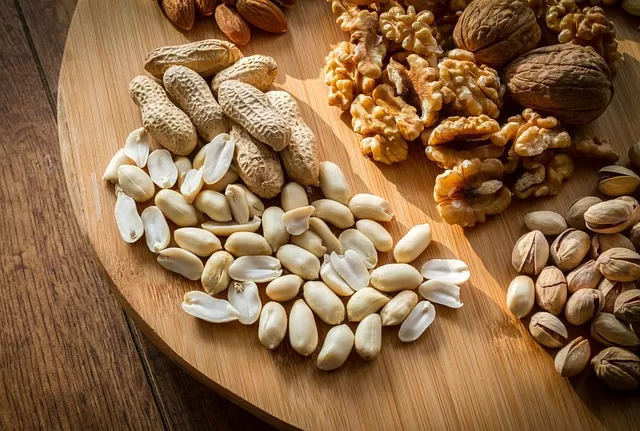This post contains affiliate links. See our Affiliate Disclosure Statement page for more details.
Table of Contents
Benefits of Dog Food with Fiber
One of the questions often asked of veterinarians is “Do I need to feed a dog food with fiber to my dog?”
Is Fiber an essential part of a dog’s diet?” and “How can fiber help my pet stay healthy and active?”
This article discusses the 5 benefits of fiber for your dog and how to ensure your loyal companion gets the fiber they need in their diets.
5 Benefits of Fiber for Dogs
- Improved Digestive Health
- Weight Management
- Blood Sugar Regulation
- Heart Health
- Anal Gland Health
**Disclaimer – The specific benefits of fiber can vary depending on your dog’s health status and dietary needs. It is important to discuss whether a higher-fiber diet is appropriate for your dog’s health needs.**
Before we examine the benefits of fiber in more detail, it is important to know the type of fiber and its sources when selecting dog food with fiber to feed your pet.
Types of Fiber
There are two main types of dietary fiber
- Soluble
- Insoluble
Soluble Fiber

Soluble Fiber, as the name suggests, dissolves in water to form a gel-like substance in the gastrointestinal (GI) tract.
Soluble fiber can provide the following benefits
- It helps regulate blood sugars
- Helps to lower cholesterol
- Promotes a feeling of fullness and satiety
Sources of soluble fiber include
- Fruits
- Vegetables
- Oats
- Legumes (beans)
For additional information on soluble fiber, read our articles
Can Boxer Dogs Eat Vegetables? 7 Delicious Vegetables to Add Variety To Your Boxer Dogs Diet
Can Boxer Dogs Eat Apples? 3 Best Reasons to Look At The Nutritional Benefits and Risks
For Fresh dog food with soluble fiber made with real fruits and vegetables, we recommend Ollie’s Fresh Turkey and Blueberry dinner. It contains blueberries, Kale, carrots, and pumpkin as sources of soluble fiber.
Insoluble Fiber
Insoluble fiber
- Does not dissolve in water
- Adds bulk to the stool to help it move through the digestive system
Insoluble fiber can provide the following benefits
- Can help with regularity
- Prevent Constipation
- Help remove waste and toxins from the digestive system
For additional information on insoluble fiber read our article
6 Authentic Benefits of Dog Food with Grain – Is it Best for Your Dog?

The table below shows types of fiber, their functions, sources, benefits, and typical percentages used in dog food with fiber.
Table – Soluble and Insoluble Fiber
| Type of Fiber | Function | Source | Benefits | Typical Percentage Used |
| Soluble Fiber | Regulates blood sugar levels, lowers cholesterol, promotes feelings of fullness | Fruits, vegetables, oats, legumes | Supports heart health, aids in weight management | 1-5% |
| Insoluble Fiber | Promotes regularity, prevents constipation, removes waste and toxins from the digestive tract | Whole grains, nuts, seeds | Supports digestive health, aids in weight management | 1-5% |
It’s important to consult with a veterinarian to determine the appropriate amount and type of fiber for your individual dog based on its specific nutritional needs.
For fresh dog food with higher amounts of Insoluble to Soluble Fiber that also had added Glucosamine and Chondroitin to support joint health, we recommend Just Food For Dogs Large Breed Support fresh dog food with real human-grade ingredients
Now that we know the types, sources, and benefits of fiber, what are the recommendations for fiber for your dog?
Dog Food With Fiber – AAFCO Recommendations
According to The Association of American Feed Control Officials (AAFCO), the minimum crude fiber content in dog food should be
- 2.5% for adult dogs
- 4.5% for puppies
However, AAFCO does not provide a maximum recommended fiber content.
It’s important to note that these guidelines are based on minimum requirements and that some dogs may require higher levels of fiber in their diet for optimal health.
The type of fiber and the source of the fiber can impact its effectiveness and suitability for different dogs.
Consulting with a veterinarian can help determine the appropriate level and type of fiber for your dog’s individual needs.
Your Veterinarian may base the recommendations for dog food with fiber on factors such as
- Age
- Breed
- Weight
- Activity level
- Existing health conditions
Now that we know the types and sources of fiber and the recommendations for dog food with fiber, let’s examine the benefits of dog food with fiber in more detail.
Dog Food With Fiber – Benefits
Dog Food With Fiber – Improved Digestive Health

Fiber can have a significant impact on a dog’s digestive health. Here are some specific details on how:
- Promotes regular bowel movements
- Fiber adds bulk to a dog’s stool, which helps move it through the digestive tract more easily.
- This can help prevent constipation and promote regular bowel movements.
- Improves digestion
- Fiber helps regulate the digestive system by slowing down the rate at which food is digested.
- This allows the body more time to extract nutrients from food and can help reduce the risk of diarrhea and other digestive issues.
- Reduces risk of colon cancer
- Soluble fiber, in particular, can reduce the risk of colon cancer by promoting the growth of beneficial bacteria in the colon.
- For additional information on beneficial bacteria, read our article Natural Probiotic Food For Dogs – Choosing the Right Probiotic Food For Your Boxer
- These bacteria produce compounds, which have demonstrated anti-cancer properties.
- Helps control blood sugar
- Fiber can slow the absorption of glucose in the bloodstream, which can help prevent blood sugar spikes and improve insulin sensitivity.
- This can be especially beneficial for dogs with diabetes.
- Reduces risk of obesity
- Fiber can help dogs feel fuller for longer periods of time.
- This can help reduce the amount of food they eat and prevent overeating.
- This can help reduce the risk of obesity and associated health problems.
Incorporating both soluble and insoluble fiber into a dog’s diet can have a positive impact on their digestive health and overall well-being.
It’s important to consult with a veterinarian to determine the appropriate amount and type of fiber for your individual dog’s needs.
For improved digestive health using probiotics, we recommend NomNom’s Full Spectrum Probiotics and GI Targeted Probiotics for Dogs. These products help increase the good bacteria in your dog’s GI tract for better digestive health.
NomNom Probiotic Support Full Spectrum for DogsDog Food with Fiber – Weight Management

Obesity in dogs, as in the human population has risen dramatically in the last 20 years.
Overweight or obese dogs are at higher risk for health problems including
- Cancer
- Diabetes
- Heart Disease
- Hypertension
- Osteoarthritis
- Urinary Bladder Stones
Source: Obesity in Dogs – VCA Animal Hospital, Weir, DVM, Williams, DVM, and Downing.
Common Causes of Weight Gain in Dogs
Some of the common causes of weight gain and obesity in dogs include
- Owners provide too much food and treats.
- Poor quality diet – too much fat and fillers in dog food
- Lack of exercise or not enough exercise for the breed.
- Aging – older dogs typically slow down and decrease their exercise with age.
- Medications – certain medications (e.g., steroids)
- Reproductive Status – Spayed females tend to gain weight easier, which may be due to increased appetite.
- Medical Conditions – (e.g., hypothyroidism)
- Background – Puppy Mill dogs are often not fed very often and when adopted and they have the opportunity to eat, will often overeat.
References:
Obesity in Dogs – Symptoms, Causes and Diagnosis, WagWalking.com
For additional information on how much to feed your Boxer and Feeding Schedule for your Boxer read our articles
How Much Should I Feed My Boxer? Comprehensive Feeding Chart
How Much Should My Boxer Dog Weigh? 5 Helpful Tips to Keep Your Boxer’s Weight Healthy
Boxer Dog Feeding Guide: 4 Top Diets Compared for Nutrition
Dog Food With Fiber – How Fiber Can Help Manage Weight
Fiber can help manage your dog’s weight by
- Provides a feeling of fullness so your dogs eat less
- Consume fewer calories since fiber is not digested and absorbed for nutrients
- Help moderate blood sugar levels
- Helps prevent constipation so your dog can excrete excess waste.
For fresh dog food that has fiber to keep your dog’s hunger satisfied, We recommend NomNom’s Chicken Cuisine and Turkey Fare Meals. They contain both soluble and insoluble fiber to help keep your dog fuller longer.
Dog Food With Fiber – Blood Sugar Regulation

Image by Rebekka D from Pixabay
Feeding your Boxer dog food with fiber can be beneficial in helping to regulate their blood sugar.
One of the benefits fiber provides is the body does not digest it so it stays mostly intact as it passes through the GI tract.
Because fiber is not digested and it helps slow down the absorption of sugar (glucose) into the dog’s bloodstream.
When sugar spikes it causes hunger pangs causing the dog to want to eat more.
Because sugar is absorbed more slowly it keeps the dog feeling fuller for longer periods of time. This can help prevent them from overeating.
Dog food with fiber, especially soluble fiber, from fruits and vegetables can be beneficial for dogs with diabetes or those at risk of developing diabetes because it can help regulate blood sugar levels.
For fresh dog food with lots of soluble fiber to help prevent blood sugar spikes, we recommend Ollie Lamb with Cranberry meals. It has cranberries, butternut squash, kale, and chickpeas as soluble fiber ingredients.
Dog Food with Fiber – Heart Health

Dog food with fiber can provide a host of benefits in promoting heart health for your Boxer.
The benefits include
- Regulates Blood Cholesterol Levels
- Fiber binds to the excess cholesterol in the intestines and removes it from the body.
- Helps reduce the risk of high cholesterol which is a major contributing factor to heart disease.
- Helps Reduce Blood Pressure
- Fiber helps reduce the absorption of sodium, a mineral that can raise blood pressure when consumed in excess.
- Promotes Weight Management
- Fiber helps increases the feeling of fullness
- Helps reduce the number of calories the dog consumes due to feeling full.
- Helps Maintain a Healthy Weight
- Maintaining a healthy weight is essential for heart health
- Excess fat can strain the heart and increase the risk of heart disease.
Dog food with fiber such as beet pulp, psyllium husk, and oat bran are excellent sources of fiber that promote heart health.
To help you identify dog food with fiber that contains fiber that is beneficial for heart health, the table below lists the types of fiber, their typical percentages, and the heart health benefits they can provide.
Table – Dog Food with Fiber that Promotes Heart Health
| Type of Fiber | Percentage | Benefits to Heart Health |
| Beet Pulp | 2-5% | Promotes healthy cholesterol levels and weight management |
| Psyllium Husk | 1-3% | Helps regulate blood sugar levels and reduces the absorption of cholesterol and sodium |
| Oat Bran | 5-10% | Contains beta-glucans that can help lower cholesterol levels and promote weight management |
| Flaxseed | 2-3% | Contains omega-3 fatty acids that can help reduce inflammation and improve heart health |
| Chicory Root | 4-6% | Contains inulin, a prebiotic fiber that can help support healthy digestion and reduce the risk of obesity, a risk factor for heart disease |
| Soybean Hulls | 6-8% | Promotes healthy digestion and weight management |
We recommend Wervuva Pumpkin Patch Up Supplements for dogs because they are a great source of soluble fiber that can promote heart health. Click on the link below for more information.
Weruva Pumpkin Patch Up Supplements for DogsDog Food with Fiber – Anal Gland Health

What are anal glands and why are they important?
Anal glands, also known as anal sacs or scent glands, are small, sac-like structures located on either side of a dog’s anus, just beneath the skin.
They are present in most mammals and are believed to have evolved as a means of communication and defense.
In dogs, anal glands play an important role in
- Marking Territory
- Identifying Other Dogs
- Conveying Social Information
The anal glands in dogs produce a secretion that is released through a small duct or opening near the anus.
This secretion is a complex mixture of chemicals, including fatty acids, proteins, and pheromones, that provide information about the dog’s
- Identity
- Age
- Sex
- Reproductive Status
When a dog defecates, the pressure of the stool passing through the rectum can cause the anal glands to empty their contents, leaving a distinctive scent on the feces.
While anal glands are a natural and necessary part of a dog’s physiology, they can sometimes become impacted or infected.
This can occur when the glands fail to empty properly, leading to a buildup of fluid that can become thick, sticky, and foul-smelling.
Dogs with impacted or infected anal glands may exhibit signs of discomfort, such as
- Excessive licking
- Biting at the anus
- Scooting or dragging their butts on the ground or across the carpet
- Reluctance to sit down
To prevent and treat anal gland problems, it’s important to have your dog’s glands checked regularly by a veterinarian or a groomer who is trained in expressing them manually.
Some dogs may require more frequent gland expression due to underlying health conditions or dietary factors that affect the consistency of their stool.
In severe cases of anal gland problems, surgery may be necessary to remove the glands entirely.
Fibers Benefits to Anal Gland Health
Dog food with fiber can help promote anal gland health by
- Promoting Healthy Bowel Movements
- Reduces the risk of anal gland impaction or infection
- Adds Bulk to Stool
- Makes stool easier to pass through the colon and rectum
- Regular defecation and the right consistency can allow the stool to pass out of the body
- Helps to empty the anal glands naturally helping to reduce the risk of impaction or infection.
- Helps Regulate the Dog’s Digestive System
- Helps reduce the risk of diarrhea and constipation
- Diarrhea can fail to stimulate the anal glands when pooping leading to impaction
- Constipation can cause dry, hard poop that is hard to pass causing increased pressure on the anal glands and impaction.
Dog foods with added fiber, such as pumpkin, sweet potato, or beet pulp, can be helpful dietary addition to promote anal gland health in dogs.
Adding fiber to your dog’s diet can help prevent and manage anal gland problems and reduce the need for manual gland expression, which can be uncomfortable and stressful for dogs.
However, it’s always essential to consult with a veterinarian before making any significant dietary changes for your dog to ensure that the food is appropriate for their individual health needs.
If your Boxer has problems with its anal glands we recommend Glandex Anal Gland and Digestive Support for Dogs available at PetCareRx.
Save an Extra 25% OFF Sitewide + Enjoy Free Standard Shipping on orders $48+ only at PetCareRx.com! Use Code: CARE25Types of Fiber Used in Dog Food With Fiber
So, we now know the benefits that fiber can have for your Boxer.
How do you identify the types of fiber used in dog food with fiber when looking at the ingredient label?
The table below lists commonly used fibers and their corresponding percentages.
Table – Commonly Used Fibers in Dog Food
| Ingredient Adding Fiber | Average Percentage |
| Beet Pulp | 2-7% |
| Psyllium Husk | 1-5% |
| Sweet Potatoes | 3-7% |
| Brown Rice | 1-3% |
| Flaxseed | 2-5% |
| Peas | 3-5% |
It’s important to note that the specific percentages of fiber in dog foods can vary depending on the brand, type, and formulation of the food.
The percentages listed here are meant to provide a general range and should not be taken as absolute values.
Additionally, it’s important to consult with a veterinarian to determine the appropriate amount of fiber for your individual dog based on their specific nutritional needs.
You can now identify the commonly used fibers by looking at the ingredient listing.
However, it’s also important to know what each type of fiber’s function and benefit to your Boxer are.
To make this easier for you, the table below lists the commonly used fibers in dog food with fiber, their functions, and the benefits they provide your dog.
Table- Fibers and their Benefits
| Ingredient Adding Fiber | Function | Benefits |
| Beet Pulp | Provides insoluble fiber, which helps regulate bowel movements and promote colon health. | Supports digestive health, helps with weight management, and can reduce the risk of colon cancer. |
| Psyllium Husk | Provides soluble fiber, which can help regulate blood sugar levels and reduce cholesterol. | Promotes digestive health, reduces the risk of heart disease, and can help manage diabetes. |
| Sweet Potatoes | Provides complex carbohydrates and fiber, which can help regulate blood sugar levels and provide sustained energy. | Supports digestive health, provides vitamins and minerals, and can reduce the risk of cancer. |
| Brown Rice | Provides complex carbohydrates and fiber, which can help regulate blood sugar levels and provide sustained energy. | Supports digestive health, provides vitamins and minerals, and can reduce the risk of cancer. |
| Flaxseed | Provides both soluble and insoluble fiber, as well as omega-3 fatty acids, which can promote heart and joint health. | Supports digestive health, promotes a healthy coat and skin, and can reduce inflammation. |
| Peas | Provides both protein and fiber, which can help regulate blood sugar levels and provide sustained energy. | Supports digestive health, provides vitamins and minerals, and can reduce the risk of cancer. |
It’s important to note that the specific benefits of each ingredient may vary depending on the individual dog’s health and nutritional needs.
It’s always a good idea to consult with a veterinarian to determine the appropriate diet for your dog.
For Fresh dog food with Peas try NomNom’s Beef Mash, which contains Beef, Potatoes, Eggs, and Peas.
Take 50% off Your First Order of Nom NomSummary
Dog food with fiber can have a positive impact on your dog’s overall health.
Fiber provides many benefits including
- Improved digestive Health
- Weight Management
- Blood Sugar Regulation
- Heart Health
- Anal Gland Health
It’s always important to check with your veterinarian before increasing the amount of fiber in your dog’s diet.
Too much fiber can cause gas, diarrhea, and bloating.
To keep your Boxer dog happy and active, talk to your veterinarian about the amount and types of fiber your dog should be eating as part of their diet.

Discoverboxerdogs.com are Mary and Chris Kustanbauter. We reside in Red Lion, PA with our two Boxers, Duke and Katie, who are both rescue dogs. We have been working with Adopt A Boxer Rescue for the past 17 years and have adopted 5 Boxers from this fine organization. To learn more visit our Home, Boxer Dog Family, and Blogs Pages Visit us on social media on Facebook – Discoverboxerdogs.com, Instagram, and Pinterest


